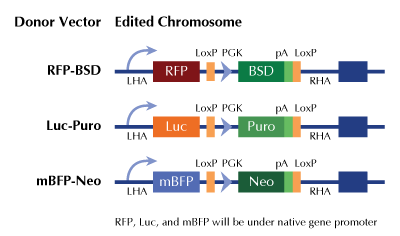MET Human Gene Knockout Kit (CRISPR)
CAT#: KN217003BN
MET - human gene knockout kit via CRISPR, HDR mediated
HDR-mediated knockout kit validation
CNY 12,260.00
CNY 3,710.00
CNY 1,999.00
CNY 2,700.00
CNY 14,264.00
Specifications
| Product Data | |
| Format | 2 gRNA vectors, 1 mBFP-Neo donor, 1 scramble control |
| Donor DNA | mBFP-Neo |
| Symbol | MET |
| Locus ID | 4233 |
| Kit Components |
KN217003G1, MET gRNA vector 1 in pCas-Guide CRISPR vector KN217003G2, MET gRNA vector 2 in pCas-Guide CRISPR vector KN217003BN-D, donor DNA containing left and right homologous arms and mBFP-Neo functional cassette. GE100003, scramble sequence in pCas-Guide vector |
| Disclaimer | These products are manufactured and supplied by OriGene under license from ERS. The kit is designed based on the best knowledge of CRISPR technology. The system has been functionally validated for knocking-in the cassette downstream the native promoter. The efficiency of the knock-out varies due to the nature of the biology and the complexity of the experimental process. |
| Reference Data | |
| RefSeq | NM_000245, NM_001127500, NM_001324401, NM_001324402 |
| Synonyms | AUTS9; c-Met; DFNB97; HGFR; RCCP2 |
| Summary | This gene encodes a member of the receptor tyrosine kinase family of proteins and the product of the proto-oncogene MET. The encoded preproprotein is proteolytically processed to generate alpha and beta subunits that are linked via disulfide bonds to form the mature receptor. Further processing of the beta subunit results in the formation of the M10 peptide, which has been shown to reduce lung fibrosis. Binding of its ligand, hepatocyte growth factor, induces dimerization and activation of the receptor, which plays a role in cellular survival, embryogenesis, and cellular migration and invasion. Mutations in this gene are associated with papillary renal cell carcinoma, hepatocellular carcinoma, and various head and neck cancers. Amplification and overexpression of this gene are also associated with multiple human cancers. [provided by RefSeq, May 2016] |
Documents
| Product Manuals |
| FAQs |
Resources
| 基因表达相关资源 |
Other Versions
| SKU | Description | Size | Price |
|---|---|---|---|
| KN217003 | MET - human gene knockout kit via CRISPR, HDR mediated |
CNY 12,260.00 |
|
| KN217003LP | MET - human gene knockout kit via CRISPR, HDR mediated |
CNY 12,260.00 |
|
| KN217003RB | MET - human gene knockout kit via CRISPR, HDR mediated |
CNY 12,260.00 |
|
| KN417003 | MET - KN2.0, Human gene knockout kit via CRISPR, non-homology mediated. |
CNY 8,680.00 |
|
| GA102883 | MET CRISPRa kit - CRISPR gene activation of human MET proto-oncogene, receptor tyrosine kinase |
CNY 12,255.00 |


 United States
United States
 Germany
Germany
 Japan
Japan
 United Kingdom
United Kingdom
 China
China

